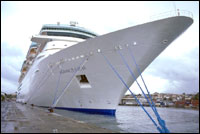Quick — what’s the third-largest city in Alaska?
For all intents and purposes, during the summer, it is the 45,000 people found on the dozens of cruise ships that ply that state’s southeastern coastal waters. And the effects of that “city” on the natural environment are indeed urban, in the worst imaginable ways.
Cruise Ship Blues By Ross A. Klein New Society, 200 pages, 2002
The average cruise passenger produces 10 gallons of concentrated sewage every day. Before I began to read Cruise Ship Blues: The Underside of the Cruise Industry, Ross Klein’s diatribe against pleasure cruises, I had never thought much about what happens to sewage on cruise ships. Few people have — even among environmentalists. That fact in itself underscores how this burgeoning industry has managed to navigate largely beneath the environmental radar screen.
To the extent that I’d thought about sewage on ships at all, I had always assumed that it was kept on board until it could be transferred to some sort of land-based treatment system. If only. The reality, as Klein explains, is that sewage is simply dum... Read more

